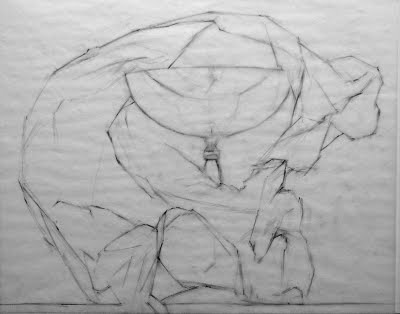 Wrapped Silver Goblet (in progress)
Wrapped Silver Goblet (in progress)
11 x 14 inches
graphite pencil on trace paper
I have a couple teaching opportunities coming up which I am very excited about: I'll be teaching drawing this fall semester to first-year MFA grad students at San Francisco's Academy of Art University, and there are plans in the works to possibly do a couple workshops next year (I'll keep you posted).
All of these opportunities are really exciting, and as I have been thinking about them I find I am "teaching" myself as I work all the time. Observing myself as I work helps me avoid problems deeper in the drawing. It's a sort of narration: At first it was non-verbal narration, simply paying attention to what I see and and comparing that to my drawing. But since I have begun teaching, that internal narration is becoming more and more verbal, as I imagine how I would teach as I draw.
I've been working the last couple days to begin a few new paintings of still life, and my first step is using straight-line block-in to establish the composition and forms.
graphite pencil on trace paper
6 x 8 inches
Block-in for me is always the most stressful stage of a painting or drawing. Positioning the correct placement and shape on that blank space feels like plotting a course across the Atlantic.
I put the first few lines down and for a short while I feel like everything is going great, and then as I move into the next level of detail the errors begin to show up. And since the initial block-in is defining the whole shape with only a few lines, the errors are usually quite drastic and devastating to the design. Panic!
graphite pencil on trace paper
5 x 5 inches
I tell my students that drawing well is essentially learning to control a sense of constant panic (I say that because I think a lot of us are quietly panicking in drawing class, and it helps the students know everyone else is feeling the same way, including me.)
But I try to use that panic to my advantage. The "Oh, no, it's all wrong!" feeling can plummet any draughtsman into despair and temptation to abandon the drawing (or crumple, scribble, or burn it).... But it's also a useful feeling. If we can react to the feeling with calm and acceptance, and simply take it as a reminder to stop and look, it becomes a useful tool.
My confidence in the block-in process has grown with my experience and now I know if something is wrong, if I keep my head calm and just look, I'll probably figure out the problem.
Not that I always do a perfect block-in by any means. And I certainly do not do my best block-ins when I am demonstrating in front of a group. But like any mental/emotional discipline, the more you practice, the easier it is to tap into problem-solving mode and focus, even in stressful situations.

